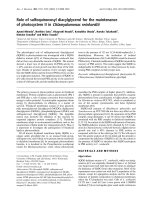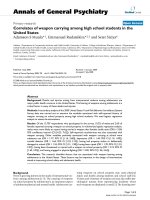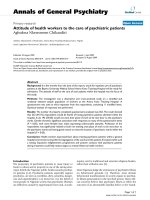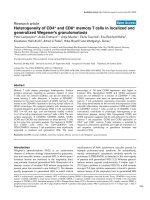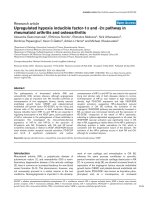Báo cáo y học: "Stress of different types increases the proinflammatory load in rheumatoid arthritis" docx
Bạn đang xem bản rút gọn của tài liệu. Xem và tải ngay bản đầy đủ của tài liệu tại đây (44.15 KB, 2 trang )
Available online />Page 1 of 2
(page number not for citation purposes)
Abstract
Stress in patients with chronic inflammatory diseases such as
rheumatoid arthritis (RA) stimulates proinflammatory mechanisms
due to the defect of stress response systems (for example, the
sympathetic nervous system and the hypothalamic–pituitary–
adrenal axis). Among other mechanisms, the loss of sympathetic
nerve fibers in inflamed tissue and inadequate cortisol secretion in
relation to inflammation lead to an enhanced proinflammatory load
in RA. Stress and the subsequent stimulation of inflammation
(systemic and local) lead to increased sensitization of pain and
further defects of stress response systems (vicious cycle of stress,
pain, and inflammation).
In 1937 Hans Selye called the activation of stress systems an
‘alarm reaction’, which is the reaction of an organism ‘when
first confronted with a stimulus to which it is quantitatively or
qualitatively not adapted’. Until the beginning of the 1980s,
the stress systems including the sympathetic nervous system
(SNS) and the hypothalamic–pituitary–adrenal axis were
thought to play a proinflammatory role by supporting the
immune response. This view was markedly changed in the
years thereafter, when targeted experiments with specific
immune cells involving hormones of the SNS and hypo-
thalamic–pituitary–adrenal axis were carried out using cell
culture. These results demonstrated that noradrenaline (via
β
2
-adrenoceptors at 10
–6
M) and cortisol (via glucocorticoid
receptor α) exert many anti-inflammatory effects. Today we
know that both proinflammatory and anti-inflammatory effects
can appear under stressful conditions, which depend on the
duration of the stress, the intensity of stress, the perception
of stress (whether positive or negative), the environmental
milieu within the body of the stressed person (whether
acutely ill or chronically ill), and the time point of stress in
relation to the outbreak of a chronic inflammatory disease
(whether before outbreak or in later phases of the
symptomatic disease). Knowledge in the stress field steadily
increases, and today we can say that patients with chronic
inflammatory diseases such as rheumatoid arthritis (RA) show
abnormal stress responses leading to proinflammatory
consequences.
Stress can be induced by pain tests, which was recently
demonstrated by Edwards and colleagues [1]. In this study
the authors used several pain tests, such as the pressure
pain threshold, the heat pain threshold, and the cold pressor
task. The patients with RA, compared with healthy control
individuals, had lower mechanical pain thresholds, lower heat
pain thresholds, and lower cold pain tolerance, all of which
are expected in a situation with peripheral sensitization to
noxious stimuli [2]. Indeed, peripheral sensitization has been
demonstrated several times in RA patients [2]. The important
and original aspect of the work of Edwards and colleagues is
the fact that pain testing increased serum levels of TNF,
which was not demonstrated in healthy control individuals.
The increase was slow over the entire observation time
without decline. A similar trend was observed for serum IL-6
[1]. This effect is interpreted as an unwanted deleterious
effect that can shape the long-term symptomatology in RA.
Edwards and colleagues’ paper adds nicely to existing
literature where, after stress testing, other groups demon-
strated a very similar effect on serum or supernatant levels (in
cell culture experiments) of proinflammatory cytokines
(Table 1). Since stress in healthy subjects can lead to an
increase of serum cytokines [3], a comparison of patients
with RA and healthy control individuals is mandatory. The
important aspect in the studies demonstrated in Table 1 is
the fact that respective control groups did not show a similar
increase of inflammation markers. Form this point of view, the
Editorial
Stress of different types increases the proinflammatory load in
rheumatoid arthritis
Rainer H Straub
1
and Joachim R Kalden
2
1
Laboratory of Experimental Rheumatology and Neuroendocrino-Immunology, Division of Rheumatology, Department of Internal Medicine I, University
Hospital, 93042 Regensburg, Germany
2
Department of Medicine 3, University of Erlangen–Nuremberg, Nikolaus-Fiebiger-Center, 91054 Erlangen, Germany
Corresponding author: Rainer H Straub,
Published: 17 June 2009 Arthritis Research & Therapy 2009, 11:114 (doi:10.1186/ar2712)
This article is online at />© 2009 BioMed Central Ltd
See related research by Edwards et al., />IL = interleukin; RA = rheumatoid arthritis; SNS = sympathetic nervous system; TNF = tumor necrosis factor.
Arthritis Research & Therapy Vol 11 No 3 Straub and Kalden
Page 2 of 2
(page number not for citation purposes)
tested RA patients demonstrate a markedly different situation.
We recently summarized the various arguments and
concluded that stress increases the proinflammatory load in
patients with RA because the stress response systems are
defective [4].
For example, it has been demonstrated that sympathetic
nerve fibers are lost in inflamed tissue of patients with RA
(reviewed in [4]). In parallel, sensory nerve fibers containing
the major proinflammatory neuropeptide substance P sprout
into inflamed tissue (reviewed in [4]). Since application of
noradrenaline at high concentrations (10
–6
M) via β
2
-adreno-
ceptors is anti-inflammatory by strongly inhibiting TNF, the
loss of sympathetic nerve fibers in inflamed tissue of RA
patients leads to a proinflammatory situation (TNF is stimu-
lated via substance P receptors and α-adrenoceptors at low
noradrenaline concentrations of 10
–8
M). The balance
between the nociceptive system (substance P) and the SNS
(noradrenaline) is shifted to the proinflammatory site. Under a
situation of stress, the usual anti-inflammatory influence of the
SNS is no longer functional because of the dramatic loss of
sympathetic nerve fibers.
Similar arguments exist for the hypothalamic–pituitary–
adrenal axis, where stress tests in RA patients demonstrated
a decreased stress response. Dekkers and colleagues have
demonstrated that RA patients, as compared with control
individuals, do not mount a significant adrenocorticotropic
hormone response upon controlled psychological stress,
which is also visible in the form of an inadequate cortisol
secretion during the test phase [5]. It has been demonstrated
that controlled exercise-induced release of cortisol was
markedly decreased in patients with RA as compared with
control individuals (reviewed in [4]). The usual anti-inflam-
matory cortisol response is therefore inadequately low in
relation to inflammation, particularly, in stressed RA patients.
In conclusion, under chronic inflammatory conditions we
observe defects of the stress axes with inadequate secretion
of cortisol and a functional loss of synovial sympathetic nerve
fibers, which generate the basis for stress-induced
aggravation of the disease. Elevated local or systemic levels
of proinflammatory cytokines stimulate a vicious cycle of
increased pain most probably relevant for peripheral and
central sensitization.
Competing interests
The authors declare that they have no competing interests.
References
1. Edwards RR, Wasan AD, Bingham III CO, Bathon J, Haythornth-
waite JA, Smith MT, Page GG: Enhanced reactivity to pain in
patients with rheumatoid arthritis. Arthritis Res Ther 2009, 11:
R61.
2. Schaible HG, Del RA, Matucci-Cerinic M: Neurogenic aspects of
inflammation. Rheum Dis Clin North Am 2005, 31:77-101.
3. Steptoe A, Hamer M, Chida Y: The effects of acute psychologi-
cal stress on circulating inflammatory factors in humans: a
review and meta-analysis. Brain Behav Immun 2007, 21:901-
912.
4. Straub RH, Dhabhar FS, Bijlsma JW, Cutolo M: How psychologi-
cal stress via hormones and nerve fibers may exacerbate
rheumatoid arthritis. Arthritis Rheum 2005, 52:16-26.
5. Dekkers JC, Geenen R, Godaert GL, Glaudemans KA, Lafeber
FP, van Doornen LJ, Bijlsma JW: Experimentally challenged
reactivity of the hypothalamic pituitary adrenal axis in patients
with recently diagnosed rheumatoid arthritis. J Rheumatol
2001, 28:1496-1504.
6. Roupe van der Voort C, Heijnen CJ, Wulffraat N, Kuis W, Kave-
laars A: Stress induces increases in IL-6 production by leuco-
cytes of patients with the chronic inflammatory disease
juvenile rheumatoid arthritis: a putative role for alpha(1)-
adrenergic receptors. J Neuroimmunol 2000, 110:223-229.
7. Hirano D, Nagashima M, Ogawa R, Yoshino S: Serum levels of
interleukin 6 and stress related substances indicate mental
stress condition in patients with rheumatoid arthritis. J Rheu-
matol 2001, 28:490-495.
8. Veldhuijzen van Zanten JJ, Ring C, Carroll D, Kitas GD: Increased
C reactive protein in response to acute stress in patients with
rheumatoid arthritis. Ann Rheum Dis 2005, 64:1299-1304.
9. Motivala SJ, Khanna D, FitzGerald J, Irwin MR: Stress activation
of cellular markers of inflammation in rheumatoid arthritis:
protective effects of tumor necrosis factor alpha antagonists.
Arthritis Rheum 2008, 58:376-383.
10. Straub RH, Pongratz G, Hirvonen H, Pohjolainen T, Mikkelsson M,
Leirisalo-Repo M: Acute cold stress in rheumatoid arthritis
inadequately activates stress responses and induces an
increase of interleukin 6. Ann Rheum Dis 2009, 68:572-578.
Table 1
Stress leads to an increase of proinflammatory factors in rheumatoid arthritis
Stress Cytokine and response Reference
Cold pressor test Increase of stimulated IL-6 in cell culture (via α
1
-adrenergic receptors) [6]
Stress before surgery Increase of serum IL-6 [7]
Mental stress task Increase of serum C-reactive protein [8]
Mental stress task Increase of stimulated TNF in cell culture [9]
Acute whole body cold stress Increase of serum IL-6 [10]
Pain stress Increase of serum TNF (trend for IL-6) [1]


